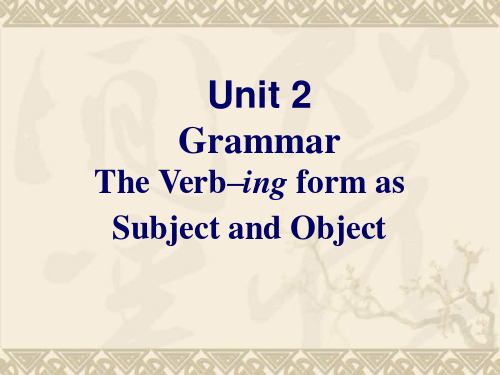高考英语动名词用法语法课件.ppt
合集下载
高中英语课件-动名词

Be careful! _T_o__p_la_y_(play)with fire will be dangerous.
具体的或一次性的动作 __S_w_i_m__m_i_n_g___(swim)is good for our health. ____T_o__s_w_i_m____(swim)in this river is not allowed
______
(laugh).
water
9.Water is uesed tgoe_tt_in_g__u_p_(water) flowers.
10.I am used to ___________(get)ewarolryk. ing
11.Though it rained,they went on_______
regret
cheating _______(say)that
we
can’t
stay
here
any longer.to say
go on doing 继续做原来做的事 go on to do 接着做另一件事
mean doing 意味着要做某事 mean to do 想要做某事
stop doing 停止做某事 stop to do 停下来(别的事)
非谓语动词
1.性质:它具有动词的特点,但在句子中起着 名词、形容词、副词的作用,充当主语、表语、 定语、宾语、宾语补足语、状语的作用,即:除 谓语以外的一切成分。
2.形式
不定式 相当于名词、形容词、副词。充
当主语、宾语、定语、表语、宾语补足语、 状语。
动名词 相当于名词充当主语、表语、定
语、宾语.
a writing desk cooking salt a dancing hall a meeting room
具体的或一次性的动作 __S_w_i_m__m_i_n_g___(swim)is good for our health. ____T_o__s_w_i_m____(swim)in this river is not allowed
______
(laugh).
water
9.Water is uesed tgoe_tt_in_g__u_p_(water) flowers.
10.I am used to ___________(get)ewarolryk. ing
11.Though it rained,they went on_______
regret
cheating _______(say)that
we
can’t
stay
here
any longer.to say
go on doing 继续做原来做的事 go on to do 接着做另一件事
mean doing 意味着要做某事 mean to do 想要做某事
stop doing 停止做某事 stop to do 停下来(别的事)
非谓语动词
1.性质:它具有动词的特点,但在句子中起着 名词、形容词、副词的作用,充当主语、表语、 定语、宾语、宾语补足语、状语的作用,即:除 谓语以外的一切成分。
2.形式
不定式 相当于名词、形容词、副词。充
当主语、宾语、定语、表语、宾语补足语、 状语。
动名词 相当于名词充当主语、表语、定
语、宾语.
a writing desk cooking salt a dancing hall a meeting room
高考必备语法动名词的用法课件 (共35张PPT)

• 归纳:常用-ing形式作主语的句型有: • It +be +a waste of time doing 做……是浪费时 间的 • It is/was no good/use doing 做……是没用处的 • It is/was hardly/scarcely worth doing 做……不 值得 • It is/was worth/worthwhile doing 做……是值 得的 • There is no doing 无法……,不允许……
• 提示:当动名词用作主语时,其逻辑主语由形 容词性物主代词和名词所有格构成。 • My sister’s being ill made we worried. • 我姐姐病了,使我很担心。 • Your being right doesn’t necessarily mean my being wrong. • 你正确未必就意味着我错了。
• ②完成式 • 动名词的完成式表示动作或状态先于谓语 动词的动作或状态,如: • They regret having been unable to help you.他 们为没能帮上你的忙而遗憾。 • After having written the letter,he went to post it. 他写完信,就去寄它了。 • She regretted having missed the film. • 她后悔没有看到那部电影。
• 三、动名词的否定式 • 动名词的否定式通常是在动名词前加否定 词not。例如: • I apologize for my not having kept promise. • 我没能遵守诺言,十分抱歉。 • I regret not being able to help you. • 我很抱歉不能帮助你。
英语动名词用法ppt课件

严格执行突发事件上报制度、校外活 动报批 制度等 相关规 章制度 。做到 及时发 现、制 止、汇 报并处 理各类 违纪行 为或突 发事件 。
2."There is no …”句式来表示
❖ There is no joking about such matters. 这种事开不得玩笑。
There is no littering about. 不许乱扔杂物。
严格执行突发事件上报制度、校外活 动报批 制度等 相关规 章制度 。做到 及时发 现、制 止、汇 报并处 理各类 违纪行 为或突 发事件 。
动名词作介词宾语
❖ 动名词作介词宾语时,通常放在由动词或形容词与介词组成 的动词短语或形容词短语后。此类短语有很多。如:look forward to(渴望,盼望), be proud of(以……自豪), be responsible for(对……负责), insist on(坚持), think of (考虑,想到), dream of(梦想), object to(反对,抗 议), hear of(听说), prevent…from(防止,阻止), keep…from(防止,阻止), stop…from(防止,阻止), be engaged in(从事于), depend on(依靠,依赖), thank…for(因……而道谢), excuse…for(因……而道 歉), aim at(目的在于), devote…to(献身于), set about(着手做), be/get used to(习惯于), be fond of (喜欢), be afraid of(害怕), be tired of(对……厌烦), succeed in(成功地做……), be interested in(对……感兴 趣), be ashamed of(对……感到羞愧)等等。
动名词的用法 ppt课件

2.意义相同
•1.Begin , start, can’t bear, continue, dislike, intend, attempt, prefer, propose • He’s beginning to learn English. • We’re proposing to start at seven. • Eddie began to realize that he had missed the
(2)它的完成式表示的动作发生在谓语动词之前。 如:
I am very pleased at your having been honoured with a medal. 我很高兴你能获得这样的奖牌。
(3)在某些动词,我们常用动名词的一般式表 示完成式,尽管动作发生在谓语动词动作之前, 这似乎是一种强大的习惯。如: Excuse me for being late. 我来晚了请你原谅。 I don’t remember ever meeting somewhere. 我 记不得原来在什么地方见过。 Thank you for giving us so much help. 谢谢给我 们这么大的帮助。 (4)在多数情况下都避免使用动名词被动语 态完成式,而用一般式代替,以免句子显得累 赘,尤其是在口语中。如: I forget once
chance
• He began to understand the meaning of what his father said.
• All of a sudden, it began to rain.
2.Like, love, hate
(2)作介词的宾语
• We are thinking of making a new plan for the next term. 我们正考虑为下学期制定新的计划。 Shall we have a rest or get down to doing our work? 我们休息呢还是开始干活?
动名词的用法讲解优秀课件

She practices speaking English every day.
2)动名词作介词宾语
动名词作介词宾语时,通常放在由动词或形容词与介词组成的 动词短语或形容词短语后。此类短语有很多。如:
look forward to(渴望,盼望), be proud of(以……自豪), be responsible for(对……负责), insist on(坚持), think of(考 虑,想到), dream of(梦想), object to(反对,抗议), hear of(听说), prevent…from(防止,阻止), keep…from(防止, 阻止), stop…from(防止,阻止), be engaged in(从事于), depend on(依靠,依赖), thank…for(因……而道谢), excuse…for(因……而道歉), aim at(目的在于), devote…to (献身于), set about(着手做), be/get used to(习惯于), be fond of(喜欢), be afraid of(害怕), be tired of(对……厌 烦), succeed in(成功地做……), be interested in(对……感 兴趣), be ashamed of(对……感到羞愧)等等。
动名词的用法讲解优秀课 件
Grammar
一.动名的词形式
语 态 时态
一般 式
完成 式
主动式 被动式
doing
being done
having done
having been done
二.动名词的用法:
1.作主语的用法:
1)动名词作主语往往表示经常性、习惯性的动作。
2)动名词作介词宾语
动名词作介词宾语时,通常放在由动词或形容词与介词组成的 动词短语或形容词短语后。此类短语有很多。如:
look forward to(渴望,盼望), be proud of(以……自豪), be responsible for(对……负责), insist on(坚持), think of(考 虑,想到), dream of(梦想), object to(反对,抗议), hear of(听说), prevent…from(防止,阻止), keep…from(防止, 阻止), stop…from(防止,阻止), be engaged in(从事于), depend on(依靠,依赖), thank…for(因……而道谢), excuse…for(因……而道歉), aim at(目的在于), devote…to (献身于), set about(着手做), be/get used to(习惯于), be fond of(喜欢), be afraid of(害怕), be tired of(对……厌 烦), succeed in(成功地做……), be interested in(对……感 兴趣), be ashamed of(对……感到羞愧)等等。
动名词的用法讲解优秀课 件
Grammar
一.动名的词形式
语 态 时态
一般 式
完成 式
主动式 被动式
doing
being done
having done
having been done
二.动名词的用法:
1.作主语的用法:
1)动名词作主语往往表示经常性、习惯性的动作。
动名词用法 ppt课件

remember to do ★讲的是将来的事,表示“不要忘 记” Remember to lock the door when you leave. 离开 时记得要锁门。
remember doing ★讲的是过去的事,表示“记起来” I remember posting that letter. 我记得寄了那封信。
在现代英语中,作宾语的动名词的完成式可用一 般 式来代替。
=We remembered seeing the film.
动名词的被动形式
动名词的被动形式表示: 它的逻辑主语是动名词表示的动作的承受者。
The question being discussed is very important. 正在讨论的问题很重要。
.The machine needs checking .(检 查)
20
regret to do★对即将要做的事表示遗憾 I regret to say I must leave tomorrogret doing★对所做的事感到后悔 I regret not having told her earlier.没能更早地告诉 她,我很后悔。
stick to 坚持
pay attention to 注意
动词+动名词主动表被动
want, need, require+dwoaintegr=ingto These flowers want
be done. =to be
watered.
.Farming methods require improving (改进)
I don’t think it any use eating so much vegetable.
必背 只接动词-ing形式而不接不定式作宾语的动词有:
remember doing ★讲的是过去的事,表示“记起来” I remember posting that letter. 我记得寄了那封信。
在现代英语中,作宾语的动名词的完成式可用一 般 式来代替。
=We remembered seeing the film.
动名词的被动形式
动名词的被动形式表示: 它的逻辑主语是动名词表示的动作的承受者。
The question being discussed is very important. 正在讨论的问题很重要。
.The machine needs checking .(检 查)
20
regret to do★对即将要做的事表示遗憾 I regret to say I must leave tomorrogret doing★对所做的事感到后悔 I regret not having told her earlier.没能更早地告诉 她,我很后悔。
stick to 坚持
pay attention to 注意
动词+动名词主动表被动
want, need, require+dwoaintegr=ingto These flowers want
be done. =to be
watered.
.Farming methods require improving (改进)
I don’t think it any use eating so much vegetable.
必背 只接动词-ing形式而不接不定式作宾语的动词有:
高中英语语法 非谓语动词 动名词的用法课件(共58张PPT)

2) I’ll remember to post the letter. 我会记着去寄信的。
3) I shall never forget seeing the famous writer. 我__永__远___不__会__忘__记__见__到__过__那__位__著__名__ 作__家__。_
4) Don’t forget to write to your mother. 不__要__忘__了__给__你__母__亲__写__信__。_
E. go on doing 和 go on to do go on doing 继续做一直在做的事; go on to do 接着做另一件事。如:
1) 请接着做这同一个练习。
P__le_a_s_e_g_o__o_n_d_o_i_n_g_ the same exercise. 2) 请做另外一个练习。 P_l_e_a_s_e_g_o_o_n__t_o_d_o_ the other exercise.
一般式 完成式
主动形式 doing
having done
被动形式 being done having been done
一. 作主语 动名词作主语时,句子有三种形式:
①动名词直接置于句首主语的位置上。 1) 捉弄别人是我们万万不能干的.
_P_la_y_i_n_g_t_r_i_ck__s_o_n_o_t_h_e_r_s_ is something we should never do. 2) 学习新单词对我来说非常重要。
_it_i_s_p_l_e_a_sa_n__t _w_o_r___w_i_t_h_y_o_u_._____
③ 在there be结构中作主语,这种结 构的意思相当于“It is impossible to do… ” 如:
3) I shall never forget seeing the famous writer. 我__永__远___不__会__忘__记__见__到__过__那__位__著__名__ 作__家__。_
4) Don’t forget to write to your mother. 不__要__忘__了__给__你__母__亲__写__信__。_
E. go on doing 和 go on to do go on doing 继续做一直在做的事; go on to do 接着做另一件事。如:
1) 请接着做这同一个练习。
P__le_a_s_e_g_o__o_n_d_o_i_n_g_ the same exercise. 2) 请做另外一个练习。 P_l_e_a_s_e_g_o_o_n__t_o_d_o_ the other exercise.
一般式 完成式
主动形式 doing
having done
被动形式 being done having been done
一. 作主语 动名词作主语时,句子有三种形式:
①动名词直接置于句首主语的位置上。 1) 捉弄别人是我们万万不能干的.
_P_la_y_i_n_g_t_r_i_ck__s_o_n_o_t_h_e_r_s_ is something we should never do. 2) 学习新单词对我来说非常重要。
_it_i_s_p_l_e_a_sa_n__t _w_o_r___w_i_t_h_y_o_u_._____
③ 在there be结构中作主语,这种结 构的意思相当于“It is impossible to do… ” 如:
动名词PPT课件

— Let me tell you something about the journalists.
— Don’t you remember ________ me the story yesterday?
A. told
B. telling
C. to tell
D. to have
tol解d 析: remember telling me意为
第1页/共33页
动名词:在句子中起名词作用,可作主,宾, 表,定的成分。
第2页/共33页
动名词的形式
一般 式
完成 式
主动形式
doing having done
被动形式
being done having been
done
第3页/共33页
一、–ing 作主语或宾语
1.作主语 ①直接置于句首
1) 捉弄别人是我们万万不能干的. Playing tricks on others is something we should never do. 2)学习新单词对我来说非常重要。 Learning new words is very important for me. 3)说比做容易。 Talking is easier than doing.
第13页/共33页
go on doing 继续做原来做的事 go on to do 接着做另一件事 mean doing 意味着要做某事 mean to do 想要做某事 stop doing 停止做某事 stop to do 停下来(别的事)开始
做某事
第14页/共33页
try doing 试着做某事 try to do 努力做某事 be used to doing 习惯于做某事 be used to do 被用来做某事 can't help doing 禁不住做某事 can't help to do 不能帮助做某事
高考英语 动名词用法语法课件

forget doing
忘记做过某事
forget to do
忘记要去做某事
regret doing
后悔做过某事
regret to do
遗憾要做某事
stop doing 停止做某事 stop to do 停下来(别的事)开始做某事 try doing 试着做某事 try to do 努力做某事 mean doing 意味着做某事 mean to do 打算做某事 go on doing 继续做用来的事 go on to do 接着做另一件事
Conclusion 2: 动名词作主语时,可位于句首, 也可以用形式主语it,而将动名词后置。 It’s no use/ no good doing sth.
Experience: It is no good _A___ after you have broken the windows. A. crying B. to cry C. cries D. cried
A. look after
B. to look after
C. looking after D. being looked after
我们不许在这游泳。 We don’t allow swimming here. 我们不许儿童在这游泳。 We don’t allow children to swim here. Conclusion 5: allow/ permit/ advise/forbid doing allow/permit/advise/forbid sb. to do
4. I really can't understand __D____ her like that. (05安徽)
A. you treat B. you to treat C. why treat D. you treating
高中动名词的用法PPT课件

C.walk in D.walking in
6. The letter that I was looking forward to ___ at last.
A. coming B. came
C. come D. being come
7.—What do you think of the book?
-Oh,excellent.It's worth ___a second time
一、动名词及动名词短语的构成
1. 构成方式:
语态 时态
主动
被动
一般式 doing
being done
完成式 having done having been done
2. 否定式:
not +动名词(doing)的各种形式
3. 动名词的复合结构: 动名词前可以有自己的逻辑主语,作为该
动词所表示的的发出者。如:
carefully. 5. The Selected Poems is well worth reading.
(二)完成式(having been done)
如果动名词所表示的被动动作在谓语所表 示的动作之前发生,有时需要用动名词的 完成被动式。但大多数情况下都避免使用 这种完成被动式,而用一般被动式代替, 以免句子显得累赘。
注 在意带有宾补的结构中,往往用it作形式宾语而 将真正宾语(动名词)放在句尾。
think
consider useless
S + find
+ no use + doing
ห้องสมุดไป่ตู้
feel like
no good
etc.
1. I consider it a waste of time arguing about it. 2. We found it useless discussing it again. 3. I don’t think it worthwhile doing it right now.
动名词的用法PPT课件

6) mean to do打算,有意要…
mean doing意味着
7)go on to do 继而(去做另外一件事情)
go on doing 继续(原先没有做完的事情)
8)202p0/r10o/1p3 ose to do 打算(要做某事)
4
proposing doing建议(做某事)
It’s no good/ use doing There’s no doing… 不可能… There’s no knowing. There’s no telling when he will be back. There’s no joking.
过去分词
done 及物动词 的过去式既表 示被动又表示 完成;个别的 过去分词(多 数为不及物动 词)并不表示 被动的意思, 只表示完成。
完成进行 to have
式2020/10/13 been doing
1
考点八 有些动词后只跟动名词作宾语,
如:admit,appreciat13
5
谢谢您的指导
THANK YOU FOR YOUR GUIDANCE.
感谢阅读!为了方便学习和使用,本文档的内容可以在下载后随意修改,调整和打印。欢迎下载!
汇报人:XXXX 日期:20XX年XX月XX日
6
stop doing 停止正在或经常做的事
3)remember to do 记住去做某事(未做)
remember doing记得做过某事(已做)
4) regret to do对要做的事遗憾
regret doing对做过的事遗憾、后悔
5)try to do努力、企图做某事
try doing试验、试一试某种办法
非谓语动词时态和语态的形式(以动词do为例)
第10讲-动名词PPT课件

A.to read
B. to be read
C. reading
D. being read
5. The library needs ______,but it’ll have to
wait until Sunday.
A.cleaning
B. be cleaned
C. clean
D. being cleaned
6. ---You were brave enough to raised
objections at the meeting.
---Well, now I regret ____ that.
A. to do
B. to be doing
C. to have done D. having done
-
18
avoid(避免), admit(承认), appreciate(欣赏、 感激), advise, can’t resist(无法抵挡), confess(坦 白), consider(考虑), delay , put off/ postpone deny(否 认), dislike, enjoy, escape(逃脱), fancy(想象、喜 欢), feel like, finish, forgive, give up, imagine, include , involve(需要)
③ 动名词的完成被动式:
I don’t remember _h_a_v_i_n_g__b_ee_n__g_iv_e_n___ (give) a chance to try this method.
④动名词的否定式:直接把not加在动名词之前
I’m sorry for my not coming tomorrow.
【高中英语语法】动名词PPT课件

(3) v.+ Gerund (object) v. + object + infinitive (complement) advise, admit, allow, consider, permit,
encourage, forbid, recommend She recommended us to visit the town of
习惯; 不定式作表语时表示具体的某一次动作,特
别是将来的动作,试比较:
His job is raising pigs.
My main job now is to teach them to read the text.
3.Object
Hearing the words, she couldn’t help thinking of her past bitterness.
There’s no telling what he’s going to do.
注②:动名词作主语与不定式作主语的区别:
动名词作主语通常表示抽象的或泛指的动
作,一般不与特定的动作执行者联系在一起;
不定式作主语通常表示具体的动作或行为, 往往与特定的动作执行者联系在一起
It’s no use crying over spilt milk. (抽象)
It’s quite necessary to read it many times.
2.Predicative
Their job is building houses. My favorite sport is swimming.
注:动名词作表语与不定式作表语的区别: 动名词作表语时表示比较抽象的一般行为、
《动名词做主语》课件

动名词做主语的语法规则
动名词做主语时,通常表示一种抽象 的概念或行为,强调动作的持续性或 习惯性。
当动名词做主语时,有时需要加上适 当的形容词或副词来修饰这个动作或 行为。
动名词做主语时,一般采用“it”作 为形式主语,放在句首,而将动名词 放在句末,形成“it+be+动名词”的 结构。
动名词做主语的特点
例如:Not understanding the instructions made me feel stupid.( 不理解指示让我觉得自己很笨。)
这句话中,否定形式的动词-ing形式“Not understanding the instructions”作为主语,表示“不理解指示”这一否定行为,强调了个 人感受。
例如:Not understanding the instructions made me feel helpless.(不理解指 示让我感到无助。)
动词-ing形式的被动形式做主语
动词-ing形式的被动形式做主语 表示某个动作是被动的、受到外
力影响的状态。
被动形式通常是通过在动词-ing 前加上“being”来实现。
例如:Reading books is my favorite hobby.(读书是我的爱好。)
这句话中,动词-ing形式“Reading books”作为主语,表示“读书”这一抽象行为,强调 了个人爱好。
动词-ing形式的否定形式做主语的例句分析
动词-ing形式的否定形式做主语时,通常表示一种否定、反对或拒绝的 行为或态度。
THANK YOU
感谢各位观看
ห้องสมุดไป่ตู้
例如:Having finished my homework, I went to bed.(完成作
英语:动名词PPT课件

homework. ⑤It`s no good getting up too late. ⑥There is no joking about the matter.
.
4
2)作宾语:
① S. + vt.+ doing
避免错过 (少) 延期 avoid
miss
delay / postpone
建议完成 (多) 练习 suggest / advise finish practise
动名词用法
.
1
1.动名词形式
语 态 时态
一般 式
完成 式
.
主动式 被动式
doing
being done
having done
having been done
2
2.动名词的用法:
1)作主语
① Doing + v. + … no use no good no fun
② It`s + a shame a waste of time/money useless dangerous
D. to be doing
.
18
3.-----What do you think of the book ? (MET89)
-----Oh, excellent. It’s worth ______a second time.
A. to read
B. to be read
C. reading
help laughing. ⑤I don`t feel like going to see the film. ⑥He was busy preparing his lessons.
.
10
.
4
2)作宾语:
① S. + vt.+ doing
避免错过 (少) 延期 avoid
miss
delay / postpone
建议完成 (多) 练习 suggest / advise finish practise
动名词用法
.
1
1.动名词形式
语 态 时态
一般 式
完成 式
.
主动式 被动式
doing
being done
having done
having been done
2
2.动名词的用法:
1)作主语
① Doing + v. + … no use no good no fun
② It`s + a shame a waste of time/money useless dangerous
D. to be doing
.
18
3.-----What do you think of the book ? (MET89)
-----Oh, excellent. It’s worth ______a second time.
A. to read
B. to be read
C. reading
help laughing. ⑤I don`t feel like going to see the film. ⑥He was busy preparing his lessons.
.
10
